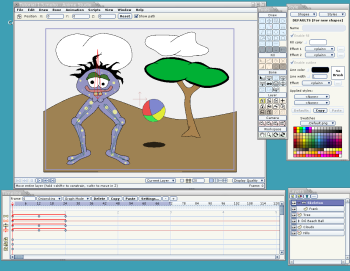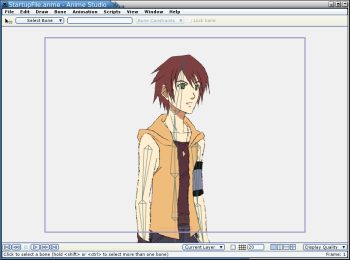Author: Bruce Byfield
Can a commercial graphics program find a market for professionals in GNU/Linux? A company called e frontier is experimenting to see if one can with Anime Studio Pro 5, an editor not only for anime, but also Flash animations, webtoons, and other forms of 2-D graphics. Compiled from much the same code as the Windows and Mac versions, the GNU/Linux version includes the same functionality, with a complex but highly organized interface and three different forms of animation.
Anime Studio Pro was originally developed under the name Moho for the BeOS platform by Mike Clifton. When BeOS failed commercially, Clifton ported Moho to Windows and Mac OS, and, in 2003, to GNU/Linux. Last year, e frontier, a company already known for such animation products as Poser, Shade, and Manga Studio, purchased and renamed Moho.
Released last month, the GNU/Linux version is the professional version of Anime Studio Pro. According to product manager Fahim Niaz, this version is intended for “professional and aspiring users” rather than the hobbyists who are the market for the basic version of the program. The Pro edition is particularly aimed at one-person studios, which lack the staff to create detailed animations quickly without computer assistance.
The GNU/Linux version is available as a downloadable demo or fully functional product for 9 in a 123MB Zip file. No retail package is available, although Fahim says that a hybrid CD with all three platform versions might be a possibility in the future.
Installation is as simple as unarchiving the download. The program does not require root privileges to install for the current account. According to the Web site, the program is known to run on Ubuntu, Fedora, SUSE, Mandrake, Debian, and Knoppix.
The interface, help, and concepts
Anime Studio Pro opens in five separate windows. The main window is the working area, where you edit individual frames and can play back entire animations. The other windows are Tools, a collection of buttons divided into six categories; Layers, for organizing drawing layers; Styles, for defining object characteristics such as fill and outline color in the same way as in OpenOffice.org Draw; and the Timeline, where animation frames are edited. Together, these windows can just be fitted comfortably onto a 19-inch monitor with a ratio aspect of 4:3, although of course you can minimize them as needed. All windows will also minimize when you minimize the working area, although, annoyingly, only the Tools window — or, sometimes, the last active window — reopens when you restore the working area.
If you have used any sort of graphics program, whether for animation or stills, much of the interface will probably be familiar to you. However, a couple of aspects may seem a little odd. For instance, because animations can devour huge amounts of memory, the working area gives you viewing options varying from wireframe — a basic outline that requires minimal memory to display — to preview, which requires the most memory. You can also choose what aspects of a drawing layer to display or, as in other graphics programs, whether to display a particular layer at all. No matter what the view settings, you can select File -> Render to see a thumbnail of the current frame.
Since you dealing with animation, you also have a number of other view options. Most computer users will be familiar with a zoom option, but in Anime Studio Pro, you can also pan, rotate, or orbit the view as you are working. You can set much the same options for the camera point of view for the current frame in the final animation. Another alternative view method is onion-skinning, which displays next and previous frames to help you edit each frame.
Similarly, although the concept of layers is common to most graphics programs, few have as many different types of layers as Anime Studio Pro — eight in all, each with its own set of options. Some of the different types of layers are based on content type, such as vector or rasterized graphics, or imported 3-D objects. Others types, such as Bones, refer to controls specific to the program. In addition, you can use Notes layers to record information, or Group layers to make global changes to all the layers within it — rather like changing the permissions of all files in a folder by changing the folder’s own permissions. With all these types of layers, you can expect projects in Anime Studio Pro to have a high number of levels, especially since the most efficient way of working is to put each moving piece into its own layer. For example, on a single figure, you would probably have separate layers for the torso, head, and each leg and arm.
Another point to mention, at least if you are new to animation, is that settings that will persist through the animation must be set when the timeline is set to frame 0. Otherwise, the settings will only be only activated for frames into which they are specifically added or copied.
The first time you start the program, the overall effect of these windows can be overwhelming. For this reason, your first stop should be the online tutorials that come with the program. One or two of these tutorials have minor omissions, but nothing that cannot be figured out in context. On the whole, the tutorials do a thorough job of explaining basic concepts and work flow. By the time you finish them, you will probably conclude that, far from being arcane as you first suspected, the interface does an admirable job of managing complexity. If some more advanced features or work methods elude you, Niaz suggests trying the still-active forums at Lost Marble, the original site for Moho.
Animation techniques
Anime Studio Pro uses three types of animation: layer animation, in which an entire layer is animated; point animation, in which lines and objects are edited individually; and bones, in which program controls are set to determine movement. By choosing which type is most appropriate for what you are doing, you can save yourself immense amounts of time.
As the name suggests, layer animation involves moving an entire layer. Having defined the initial setting, you can use the Translate Points tool to set the position of objects in the layer at another point, or keyframe. Anime Studio Pro will then automatically calculate how objects will move to get from one frame to the next. Layer animation generally seems to work best on simple objects and movements, although how well it works depends on how much content a layer has and the number of frames between the original and the keyframe.
In point animation, you manipulate points on vector graphics lines, adding points for greater detail, and using weld points to create closed shapes whose characteristics you can define by using the Styles window. In this mode, Anime Studio Pro resembles an ordinary graphics program like the GIMP. In a two-dimensional environment, this sort of animation is most useful for detail work, or perhaps for small movements of a figure.
However, the method that makes Anime Studio Pro unique among 2-D animation is bones. Like the skeletons in the 3-D animation program Maya, bones are control points that determine how an object moves. In a simple example, a figure might have one bone for the upper leg and one for the lower. But bones are not just simplified versions of anatomy — they can also be used for such complex purposes as controlling the movement of a mouth to sync with words on a sound track. Each bone can be set individually to move only within a limited range, or not to move at all. You can also sync a bone to move when another bone moves, or alter the area that moves when each bone moves. With these features, bones offer a method of animation that is less time-consuming than point animation and require less keyframes than layer animation for complex movements, making them the preferred method of animation.
The niche and its prospects
Anime Studio Pro is a niche product, with the limitations that such a description implies. It is most useful for cutout animation, rather than the cellular animation typical of a program like Toon Boom or KTune (the leading free software animation project), although its effectiveness depends very much on your willingness to take pains. It is also limited in its ability to manipulate sound, offering no editing tool beyond muting and using a single sound track for each animation. 3-D support is also limited, although it can import 3-D images and mimic three dimensions by creating alternate views and panning with the camera.
These points aside, Anime Studio Pro is a versatile tool that is easy to learn, but capable of meeting a professional’s requirements. And, on GNU/Linux, it is one of the first full-featured Flash authoring tools available under any license.
Niaz admits that this release is a gamble for e frontier. It was made from a “gut feeling, not any concrete statistics, because there aren’t any. We don’t expect any massive sales, because we understand that a lot of people who are on the Linux platform are accustomed to getting open source software. But we’re still hoping, from reviews and word of mouth, that we’ll get some momentum. We’re really interested in seeing how it will turn out.”
Niaz says that e frontier will monitor downloads of the demo and sales for a year, then determine whether to continue offering the GNU/Linux port. “If it’s successful, we’re looking to launch our other programs on the platform,” Niaz says.
Niaz expresses cautious hopes for the GNU/Linux version, noting the popularity of GNU/Linux ports of high-end programs like Maya, for whom the operating system offers greater stability than other platforms can offer. “We know that our user base has been wanting this product,” Niaz says. “We’re thinking we could take the market by storm.”
Categories:
- Linux
- Graphics & Multimedia




